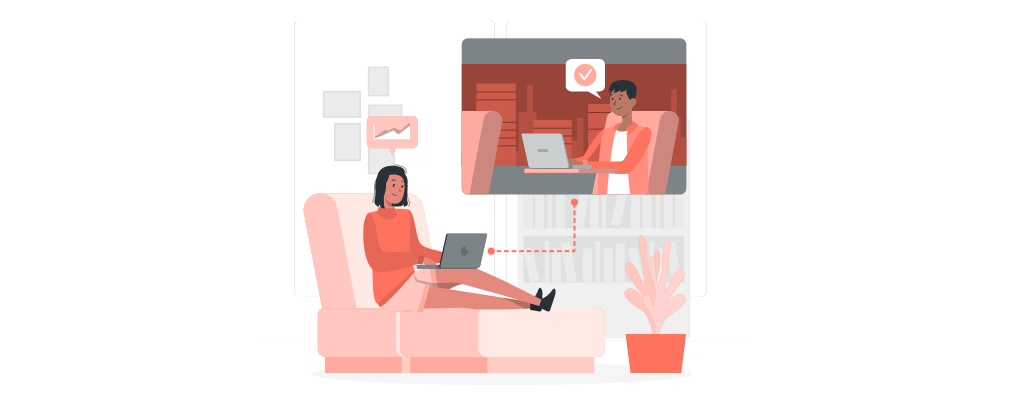
As we enter yet another year of the pandemic, the world of work is unsettling. You may be wondering what is the hybrid way of working and how can you benefit from it?
As 2022 begins, many of us may be cautiously optimistic that this could be the final year of the COVID pandemic. Vaccine boosters and new covid treatments seem to be the answer to the ongoing chaos. However, in the meantime, how do we go about our day to day lives, returning to work as if all is normal?
Many of us are returning to work in 2022 with anxiety; social anxiety, work anxiety or merely anxiety of getting sick. So how should we navigate this? Remote working seems to be a thing of the past as more and more of us are returning to offices, but what about those of us who long to be in the comfort of our homes during work days?
According to Maureen Kennedy, head of coaching at Bravely in NYC, “for life at work, there is no ‘back to normal’”. So what is the new normal then? A survey conducted by Slack, of 3,480 remotely working employees, revealed that 63% of their employees favoured a hybrid working model, compared to 20% stated they wanted to keep working remotely and only 12% expressed they wanted to return to full time in-office work. Although some employees desire to continue working full time at home, most are attracted to a balance of the two, working in office some of the week, and at home for the rest; hybrid working.
So, what is hybrid working?
2020 made it clear to us that it was no longer safe to travel to work everyday amidst a global pandemic. Remote working took over, and many adapted to working at the kitchen table or makeshift office spaces in their homes, dealing with interrupting pets and children. This strange new way of working left us wanting to get out into the world again, eager to escape the over familiarity of our homes during lockdown. But now that things are open again, where does that leave the world of work? Do we return to the office, acting as if nothing changed? Most people would agree the world of work has fundamentally changed and the way we work, how we work and where we work ought to be rethought.
Say goodbye to sweaty tube commutes and the traditional 9am-5pm work schedule. Large numbers of companies, big and small, are embracing the hybrid work model, allowing employees the freedom to choose how and where they work.
The hybrid work model is a balance of working on-site and at home, a combination of the old style full time office work and the COVID era full time remote work. Perhaps, the best of both worlds; hybrid work is the new remote work.
Overall, the hybrid work model is appealing to those who are unsure if they are ready to fully return to the office in 2022 – or if they ever want to return full time again.
What can we gain from hybrid working?
Hybrid working allows employees to work in whatever environment they feel most comfortable in; some may shine working from home, others may enjoy the office environment. The combination of the two, not only gives more autonomy to the employee, but also increases employee productivity and satisfaction. A recent survey conducted by Envoy demonstrated that 47% of employees would be likely to seek different employment if their current employers would not offer hybrid work.
Flexibility and Productivity
The hybrid work model abolishes the traditional 9-5 office model giving employees the freedom to work when suits them. This doesn’t mean that employees all around the world are slacking off. In a hybrid work model, the flexibility allows people to work around their lives, which seems to be a major flaw in the office model. It seems the office model neglects to take into account that some people work better early in the morning, while others are more productive in the evening; or some work better in a social environment, and others better solo.
Health and safety
Health and safety is a big one. Envoy also reported that 66% of employees are worried about their health and safety when asked about returning to the office. A hybrid work model encourages less people in the office at one time, lowering the change of sick employees passing on their illness. Many companies have also begun to require lateral flow testing, health screenings or proof of covid vaccinations, before allowing people to return to work. It also allows a sick employee to stay home, and still work, protecting others, and reducing absenteeism.
Mental health
In some cases, the hybrid model has had a positive impact on employees’ mental health by getting rid of some of the stresses that go along with the traditional in-office work model. It has also, due to flexibility, given employees the freedom to practice wellness to improve their mental health throughout the workday. However, there are limitations, for some, having to work from home means isolation and a lack of inspiration; which is why the hybrid model works for both.
Physical footprint
Many companies are focused on eliminating or cutting down carbon footprint and going green.
Hybrid work relies on technology, so requires companies to switch to cloud based technologies and VoIP’s. E-waste is a huge part of the global climate crisis, as technology is manufactured in the thousands, as quickly as it is disposed of.
Instead of buying tens, hundreds or even thousands of physical handsets for employees, employers can remove their physical footprint by using a remote work phone, allowing their employees to use their office landline or mobile numbers in and out of the office.
Devyce offers a ‘Teams Package’ for companies, big and small, wanting to eliminate their physical footprint and cater to the new hybrid way of working. Employers can purchase as many numbers as they need and give them out to their employees, as well as monitor the calls on the Portal. Centralising calls, inbound and outbound calls, in one place can also benefit the employee, allowing them to work more productively and concisely with a remote work phone.
Are there issues with the Hybrid Work Model?
The hybrid work model is fairly untested, as an evolutionary adaptation of remote working, so there are some issues that ought to be addressed. Just as employees are learning the new rules of hybrid working, so are employers.
Equality
Will an employer be able to ensure fairness and equality in offering a hybrid model to everyone in their team? Or will some people have to continue to work entirely at home or in the office? This could cause resentment or upset among employees, affecting productivity or morale.
Some people may want to adopt the hybrid model but be unable to work from home, due to space constraints or WIFI issues; working from home may not be productive for them at all, therefore, would they be able to work in the office everyday of the week, or is that out of the question?
Ability to Collaborate
It can be harder to collaborate with team members or bounce ideas off one another over Zoom. How can we learn and connect with each other over the computer? Would someone struggle to have their voice heard in a meeting online?
Remote employees may feel disconnected from their coworkers, causing difficulties achieving work goals. A remote work phone number, separate from their personal number, can help connect people to their coworkers, even from home, without mixing work and personal too much.
Making the most of hybrid working
Adapting to hybrid working can be difficult and there might be some growing pains. Considering the pros and cons, both employers and employees have the opportunity to make the most out of this new way of working.
For example, ‘rituals’ at home can help separate the day out as if you were in an office. When going into work, you get up, get dressed and commute everyday, in the same fashion, so the same could be done when working from home, while being able to add new elements to your routine to boost motivation even more.
Creating a clear separation between work and home can be tricky when those two overlap for half of the week. It may be difficult to manage the boundaries between work and personal life when hybrid working; measures have to be taken to make sure employees can switch off at the end of the work day and leave, although not physically, the working day behind. Devyce supports this ethos, with its ‘Do Not Disturb’ feature, in which you can pick and choose what days and times people can reach you on your Devyce number, allowing you to switch off from work despite being in the same environment.
Hybrid working is new to all of us, but, in a way, we are familiar with each section of it. Office working is traditionally how we work, and remote working has been how most of us have worked since the beginning of the pandemic; doesn’t it make sense to combine the two? Considering the pros and cons, would you be keen to adopt the ways of hybrid working?
Is hybrid working not only the new normal, but the future? The world of work has been redefined by the pandemic and the outcome is a fairer, greener and more efficient hybrid way of working.
Devyce offers a remote work phone number to support the new normal of hybrid work; see our pricing plans here: https://devyce.com/pricing/
